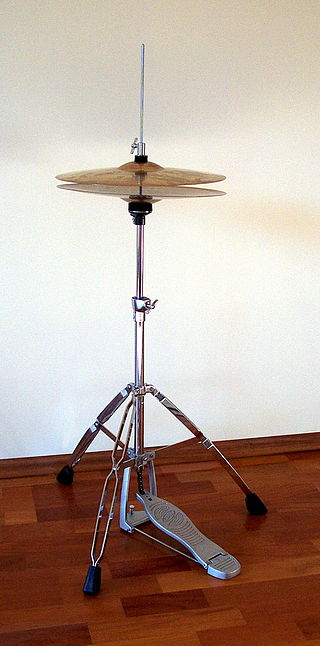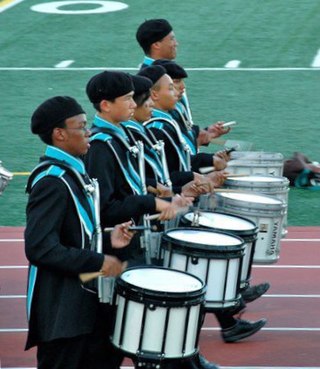
A drum kit is a collection of drums, cymbals, and sometimes other auxiliary percussion instruments set up to be played by one person. The drummer typically holds a pair of matching drumsticks, and uses their feet to operate hi-hat and bass drum pedals.

A hi-hat is a combination of two cymbals and a pedal, all mounted on a metal stand. It is a part of the standard drum kit used by drummers in many styles of music including rock, pop, jazz, and blues. Hi-hats consist of a matching pair of small to medium-sized cymbals mounted on a stand, with the two cymbals facing each other. The bottom cymbal is fixed and the top is mounted on a rod which moves the top cymbal toward the bottom one when the pedal is depressed.

The snare drum is a percussion instrument that produces a sharp staccato sound when the head is struck with a drum stick, due to the use of a series of stiff wires held under tension against the lower skin. Snare drums are often used in orchestras, concert bands, marching bands, parades, drumlines, drum corps, and more. It is one of the central pieces in a drum set, a collection of percussion instruments designed to be played by a seated drummer and used in many genres of music. Because basic rhythms are very easy to learn to play on a snare drum even for children, the instrument is also suitable for the music education for young children and a rhythm band.

The bass drum is a large drum that produces a note of low definite or indefinite pitch. The instrument is typically cylindrical, with the drum's diameter much greater than the drum's depth, with a struck head at both ends of the cylinder. The heads may be made of calfskin or plastic and there is normally a means of adjusting the tension either by threaded taps or by strings. Bass drums are built in a variety of sizes, but size does not dictate the volume produced by the drum. The pitch and the sound can vary much with different sizes, but the size is also chosen based on convenience and aesthetics. Bass drums are percussion instruments and vary in size and are used in several musical genres. Three major types of bass drums can be distinguished.
A blast beat is a type of drum beat that originated in hardcore punk and grindcore, and is often associated with certain styles of extreme metal, namely black metal and death metal, and occasionally in metalcore. In Adam MacGregor's definition, "the blast-beat generally comprises a repeated, sixteenth-note figure played at a very fast tempo, and divided uniformly among the bass drum, snare, and ride, crash, or hi-hat cymbal." Blast beats have been described by PopMatters contributor Whitney Strub as, "maniacal percussive explosions, less about rhythm per se than sheer sonic violence".
"The 'original' or traditional blastbeat is a single-stroke roll played between your cymbal and snare, with your kick playing simultaneously with every cymbal hit."

Snare technique is the technique used to play a snare drum.

A drum roll is a technique used by percussionists to produce a sustained sound for the duration of a written note.
All drum figures are based upon three fundamental beats, technically called roll, single stroke, and flam...Sustentation is accomplished upon wind instruments by blowing into the instrument; it is accomplished upon the violin and the allied instruments by drawing the bow across the string; it is accomplished upon the drum and allied percussion instruments by the roll.
THE SNARE DRUM ROLL.
The roll consists of an even reiteration of beats sufficiently rapid to prohibit rhythmic analysis. To produce an impression of sustentation, these beats must be absolutely even both in power and in sequence. Uneven beats in a roll destroy the impression of sustentation. Evenness is then the primary quality to strive for in roll; speed is the secondary quality to strive for.
There are two possible ways of producing an absolutely even sequence: (1) hand alternation of single stroke and (2) hand alternation of double strokes...The snare drum roll is produced by hand alternation of double strokes.
The "open roll" is produced by [initially] slow hand alternation. Two strokes in each hand alternately are produced by wrist movement and each beat should follow its predecessor in clock-like precision.

A shot in ice hockey is an attempt by a player to score a goal by striking or snapping the puck with their stick in the direction of the net.
A rimshot is a percussion technique used to produce an accented snare drum backbeat. The sound is produced by simultaneously hitting the rim and head of the drum with a drum stick.

In rudimental drumming, a form of percussion music, a drum rudiment is one of a number of relatively small patterns which form the foundation for more extended and complex drumming patterns. The term "drum rudiment" is most closely associated with various forms of field drumming, where the snare drum plays a prominent role. In this context "rudiment" means not only "basic", but also fundamental. This tradition of drumming originates in military drumming and it is a central component of martial music.
Drum tablature, commonly known as a drum tab, is a form of simplified percussion notation, or tablature for percussion instruments. Instead of the durational notes normally seen on a piece of sheet music, drum tab uses proportional horizontal placement to indicate rhythm and vertical placement on a series of lines to represent which drum from the drum kit to stroke. Drum tabs frequently depict drum patterns.
Stevens grip is a technique for playing keyboard percussion instruments with four mallets developed by Leigh Howard Stevens. While marimba performance with two, four, and even six mallets had been done for more than a century, Stevens developed this grip based on the Musser grip, looking to expanded musical possibilities. Stevens codified his grip and his approach to performance techniques developed during his studies at the Eastman School of Music in his 1979 book, Method of Movement for Marimba. In this book, Stevens explains that his grip is an evolution of the Musser grip, and it is sometimes called the Musser-Stevens grip.
Heel-toe technique is a foot technique that drummers use to be able to play single strokes or double strokes on the bass drum, hi-hat, or other pedals.
Ewe drumming refers to the drumming ensembles of the Ewe people of Ghana, Togo, and Benin. The Ewe are known for their experience in drumming throughout West Africa. The sophisticated cross rhythms and polyrhythms in Ewe drumming are similar to those in Afro-Caribbean music and late jazz. The original purpose of Ewe drumming were sung or performed by warriors. Now the songs and performed to celebrate or for recreational use. For example, Agbadza was originally used as a warrior dance but is now used to celebrate events.
The Moeller method, Moeller technique or whipping technique is a percussive stroke method that combines a variety of techniques with the goal of improving hand speed, power, and control while offering the flexibility to add accented notes at will.

In percussion, cymbal choke is a drum stroke or push which consists of striking a cymbal with a drum stick held in one hand and then immediately grabbing the cymbal with another hand, or more rarely, with the same hand. The cymbal choke produces a burst of sound which is abruptly silenced, which can be used for punctuation or dramatic fortissimo effects. In some modern music, namely heavy metal, it is "often employed to emphasize a particular beat or signal an abrupt conclusion to a passage." Cymbal chokes are used extensively by classical percussionists to muffle the sound of a cymbal in accordance with the composer's notation, or in an attempt to match the sustain of other instruments in the ensemble. "The effect, a sudden burst of sound, is [often] further strengthened by a single, simultaneous kick with the bass drum."
For 'choke' cymbal, strike the suspended cymbal with the tip of a wood stick and dampen the sound immediately after the duration of the note.
[In] ragtime [1890-1920]...a lot of time there would be a crash cymbal, or a choke cymbal as they called it, that was usually played with a mallet. They would strike the cymbal with one hand and choke it with the other hand. And there were different techniques for choking the cymbals. Sometimes, they would really cut the cymbal and make it real staccato...Or they would play other styles where they would let the cymbal ring a little bit and sustain itself, and then catch it.
Sanford Augustus Moeller (1878–1960) was an American rudimental drummer, national champion, educator, and author. He was born in Albany, New York on February 16, 1878, and he began his music education by studying the piano.

In percussion, grip refers to the manner in which the player holds the sticks or mallets, whether drum sticks or other mallets.
Double-drumming is a percussion technique, developed around 1900, allowing the use of both a bass and snare drum by one person, using drum sticks, prior to the invention of the bass drum pedal and leading to the availability of the drum kit. According to Len 'Hunt' Doc, double drumming allowed one player to "beat a fast four-in-a-bar bass drum, doing a close roll on snare at the same time," whereas before it would have taken two percussionists. Accomplished through close positioning of the bass and snare heads, the cymbals were played by tapping a foot pedal called a "low-boy". This style is best exemplified by early New Orleans Jazz/Second Line bands, and Baby Dodds has been called the master.
The Fulcrum grip is a four-mallet grip for vibraphone and marimba developed by vibraphonist and educator Ed Saindon. The aim of the grip is to use varying fulcrum positions and finger technique to achieve the control, speed, and power of a two-mallet grip while being able to use all four mallets.










